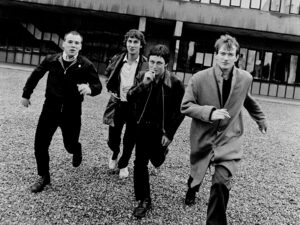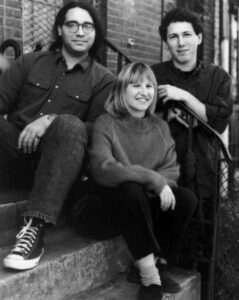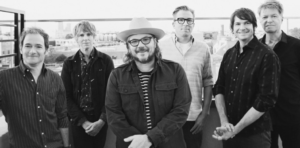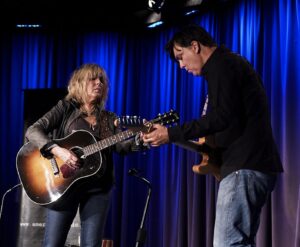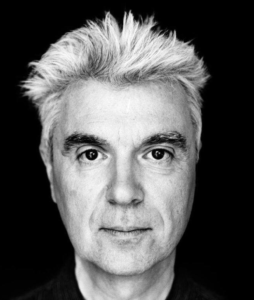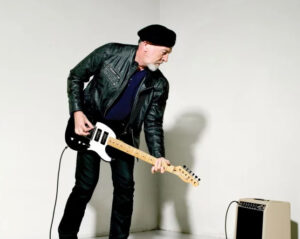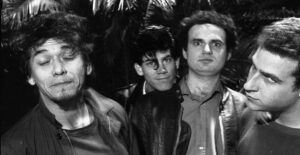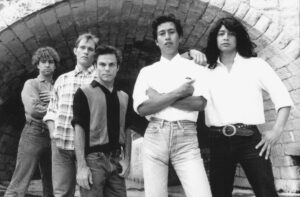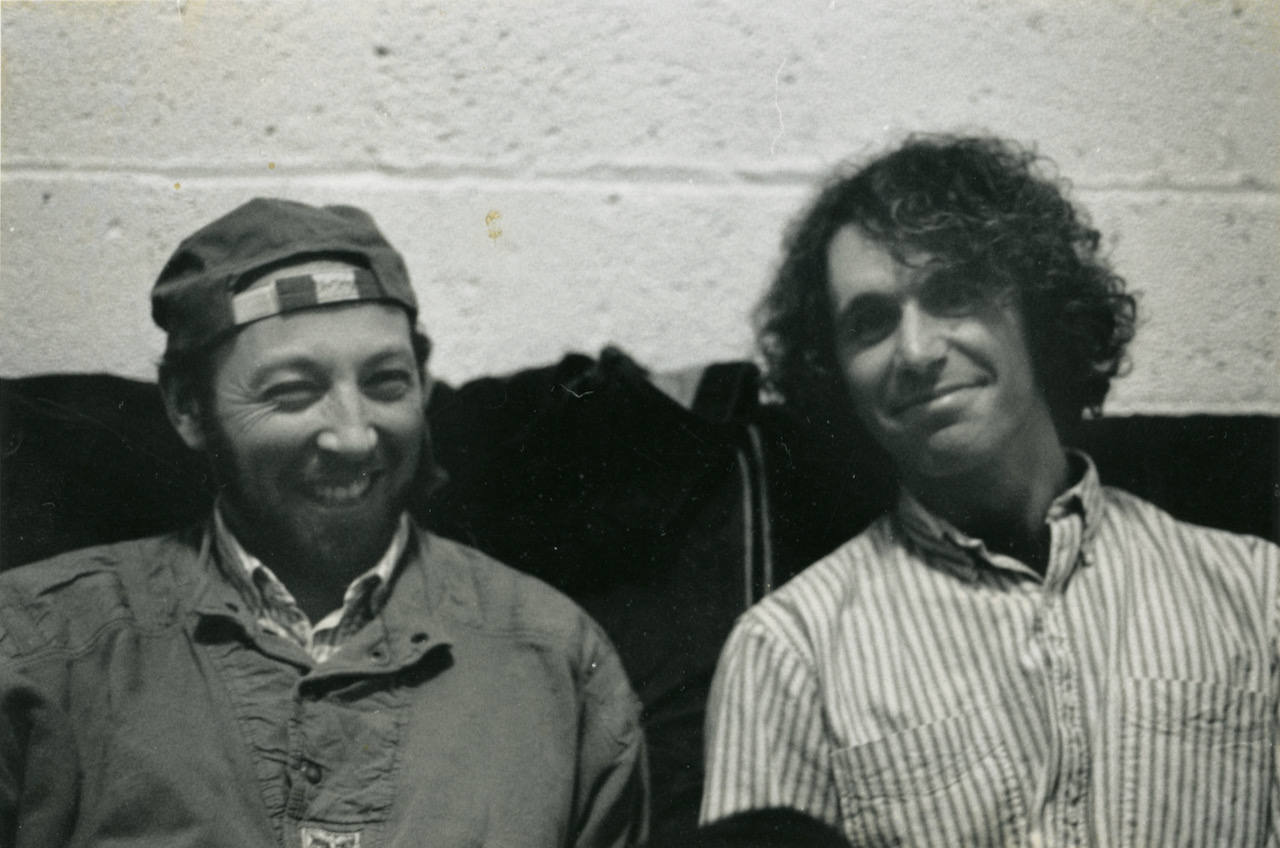
30 Aug The Shows that Mattered, Part the Troiséme
Can you believe that it’s been over a year since I started working on this series? Hard to believe on the one hand, but not so hard on the other, I guess. There’s been a few… distractions, shall we say, Humble Reader(s), along the line but all good things come to those to wait. Or perhaps to those who have nothing better to do? I know that YOU, of all people, have better things to do, but as for myself… well, I’m not so sure. This might be the best thing I can do, so it’s a damn good thing that I’m finally getting it done.
Now, I know this is at cross-purposes of a sort, but one of the distractions that I’ve been dealing with is the previously mentioned exhibition of my dad’s work at the Historic New Orleans Collection in my benighted hometown (which is, at this very moment, having its collective ass kicked by hurricane Ida). As part of that exhibition I created a 22-minute film which I have to say I’m fairly proud of. If you’ve got 22 minutes that you’ve nothing better to do with (see above) I hope you might find that if you watch my cinematic offering you might not despair of having squandered those precious minutes too carelessly. One hopes. So here’s the link to my dad’s website and its News page where the film is embedded, via the good graces of YouTube. I hope that you enjoy: https://johnclemmer.com/news
In the meantime, the show must go on and so here it is: The final installment of The Shows that Mattered. Hopefully the future will offer more Shows That Matter and one day there will be a part The Quatre, but let us not get ahead of ourselves.
Gang of Four and R.E.M.
SUB Ballroom, University of New Mexico, Albuquerque, NM, September 16, 1982
Back In The Day, the Student Union Building at the University of New Mexico campus in Albuquerque was quite the hopping concert venue. Bands of a certain degree of campus-level popularity were frequently booked into the hall by the student-run Popular Entertainment Committee. Bands that were too big for Bow Wow Records to handle but too small for the local arenas were likely to end up playing the Ballroom. During my UNM years in the early-to-mid-‘80s there was quite the run of shows by bands that included the Ramones, Hüsker Dü, the dBs, Romeo Void, the Butthole Surfers and many others that are lost to the mists of time that exist betwixt and between my earholes. Bands from the local scene were often booked in as well, either as openers for out-of-towners or as part of a lineup of homegrown offerings.
One show that stands out as being particularly memorable was the combo of opening act R.E.M. and headliners Gang of Four who took the SUB Ballroom stage in late summer, 1982. R.E.M. were relative unknowns, recently signed to IRS Records and on the road to push their inaugural ‘Chronic Town’ EP. Gang of Four—the pride of Leeds, England, (along with Damien Hirst and Peter O’Toole)—were the grizzled veterans with three releases under their collective belt, starting with the epochal ‘Entertainment,’ 1979. The follow up album, ‘Solid Gold,’ was also excellent, but ‘Entertainment’ was a true revelation. The minimalist production, Thatcher-era leftist politics, catchy-but-weird odes to alienation, and Andy Gill’s jagged, aggressive guitar work were revelatory. It was an irresistible combo for impressionable young avant garde-y sorts such as Your Humble Narrator. My friends and I scarfed up tickets and awaited the blessed day with bated breathiness.
There was a substantial crowd on the night of the concert (the ballroom having a capacity of approximately 1,000) and there was a lot of buzz regarding the gig. New Mexico was rarely favored with visitations from genuine Brit punk/pop/post notables such as Go4, so this was a truly special occasion. R.E.M. were shaggy and jangly and put on a pretty good show, but it’s unlikely that anyone would have guessed that they were going to turn into the international juggernaut that were to become by 1990. The band was then dragging ass around the country in a raggedy van and humping their own gear. I buttonholed Pete Buck as he wheeled his amp through the hallway outside the ballroom after their set and we talked for a few minutes about the band. When I told him I worked in a record store he earnestly begged me to push the record. ‘I really want to be able to do this for a living,’ he said. A few years later, when the band was on the verge of the big big time, R.E.M. returned to the SUB Ballroom as headliners, with the dBs opening the show. I again buttonholed Pete Buck to commiserate but he pretty much ignored me. I did, however, become friendly with Peter Holsapple of the dBs and we spent some quality hang time together when I was living behind Bow Wow Records and later in his New Orleans days with the Continental Drifters.
My co-attendee at the Gang of Four concert was the Goof, who was at least as much of a fan of the Gang as I was. In inimitable Goof manner he scoffed at R.E.M. (shaggy and jangly not being his cup o’ tea) but he was massively stoked for Go4. In all honesty, I cannot say that I can recall much in the way of detail regarding the Gang’s set other than it was amazing. They had a level of intensity that was pretty… well… intense? And they were really, really good—super tight, with a huge sound that elevated the songs from the records to a whole different level (despite its unquestionable excellence, the sound on ‘Entertainment’ was pretty thin—the drums, in particular, sounded like cardboard boxes).
In addition to Gill, the lineup featured Sara Lee on bass and Go4 co-founders Jon King on vocals and Hugo Burnham on drums (Burnham was soon given the boot in favor of a drum machine that had a more suitably Maoist orientation). The thing that really got us was Andy Gill’s guitar playing. He was wielding something oddball, like a Burns or a Kent or some other obscure Brit pawnshop special, and it appeared to be augmented with a button that he would push rhythmically to disconnect the output for an abrasive, pulsing effect. Gill would stand at the edge of the stage and stare fixedly out into space above the heads of the audience with a grim Clint Eastwood-quality squint, summoning forth a wall of howling feedback from his hockeystick-looking instrument. During the extended noise intro to ‘Anthrax’ the Goof started grabbing me, yelling ‘OH MY GAWD!!!! This guy is on HEROIN!! HE WANTS TO KILL US!!!’—all these observations being offered as compliments of the highest order.
Besides being a sucker in general, I have always been a sucker for art/noise/feedback guitar racket bands, and Gang of Four resided in my sweet spot for a long time. I never had the opportunity to see them again, but Andy Gill remained the one essential member of the group until his untimely passing in early 2020. The band never came close to cracking the top 100 on the US charts and never really had a bonafide hit in the UK charts either, but they were hugely influential and toured steadily for over 40 years. Gill’s guitar playing remains with me to this day as a high water mark in post-punk anti-virtuosity.
Yo La Tengo
Fat Chance, Albuquerque, NM, February 9, 1988
Of all the inconsequential nowheresville venues in Albuturkey back in the mid/late ‘80s, few were more inconsequential than the Fat Chance. It was just a boring, crappy little university area watering hole that happened to occupy a choice spot on Central Avenue directly across from the UNM campus. Other than that, nothing much to recommend it. Be that as it may, it was a venue nonetheless and therefore served a purpose. The late, great Garrett Whatley occasionally booked acts into the Fat Chance, probably when he couldn’t find a more auspicious venue to take the gig, and this was almost certainly how Yo La Tengo ended up darkening the doorway of the joint back in 1988.
Now, Le What, as he was affectionately known, was a true music connoisseur— an aficionado of the first water. An Albuquerque native and college acquaintance of Bow Wow Records impresario Andy Horwitz, he had returned to Albuquerque from LaCrosse, Wisconsin, sometime around the mid-80’s with his fabulous babe girlfriend Paula in tow. Le What had played in bands back in America’s Dairyland but in New Mexico he focused on booking shows, both via Bow Wow and as an independent presenter. He had a lot of contacts with musicians and music labels and began putting them to use, setting up gigs for the army of indie bands crisscrossing the nation. As noted previously, the Duke City was well situated as a stopover for groups navigating the vast stretches of picturesque nothingness that constitute so much of the American West, and Ira Kaplan and his cohorts happened to straggle into town one dead-ass Tuesday night in the dreary month of February.
The Yo La’s had a couple of albums under their collective belt by early ‘88 but remained an obscure quantity in the hinterlands beyond Hoboken. ‘Headlining’ at El Oportunidad Gordo was the best gig that Le What could offer them. Being the true believer that he was, Le What set to work putting out the word that the Yo La’s were hot shit and the show was not to be missed. Being a true believer in Le What’s true belief, I dutifully presented myself that evening and forked over the $5 or whatever was being requested at the door.
Le What had hired in a modest PA system from some local hippie dude who seemed to be more attuned with Grateful Dead cover bands than he was with the alt/indie/post- or pre-whatever it was that the Yo La’s were laying down. I cannot attest as to whether there had been a soundcheck that evening but it seemed that communications betwixt and between the band (Ira on guitar and vocals, Georgia Hubley on drums and vocals, Stephan Wichnewski on bass) and the sound man were not optimal. The Fat was small (as in ‘not big’) and the sound dude was apparently of the opinion that the band should modulate their volume level accordingly while the band, alternatively, was of the opinion that they would play their gig as per usual. Both parties interpreted the almost complete dearth of audience members as reinforcement for their opposing stances on the matter. My best estimate of the attendance places it about seven. Perhaps ten, max.
So, the festivities ensued and things began going pear-shaped almost immediately. There seemed to be something not quite right within the band, and even less right with the sound-hippie dude. Sound dude began pacing back and forth in front of the group, shaking his head and behaving in a manner of aggrieved agitation. At some point he began approaching Ira and Stephan’s amps, attempting to interfere with their settings. Such approaches were rebuffed. Harsh words were spoken. Le What and the sound dude started screaming at one another. The tension level escalated and the band starting venting their frustration by cranking up even further and attacking their instruments with renewed aggression. Eventually whatever song the Yo La’s had been playing dissolved into complete chaos. Georgia and Stephan were pounding and bashing and Ira let loose with a howling barrage of feedback that went on and on and on and on… By this point sound dude had totally lost it and was standing in front of the band gesticulating and yelling inaudibly. At some point I believe he turned the PA off completely and left.
Eventually the band smashed and crashed and howled to a halt. The mayhem had lasted for a half hour or so. The Yo La’s threw down their gear and stomped out the door. I recall sitting there thinking ‘Holy shit!! That was INSANE!!’ It was simultaneously thrilling, horrifying and hilarious.
Ira Kaplan picks up the narrative:
“…we’re done and I’m standing outside trying to breathe, a stranger interrupts the guy screaming at me to counter, ‘That was the best show I’ve ever seen,’ (though we’re pretty sure he didn’t see it). ‘You are as good as the Eagles. You are better than Ace Frehley.’ We would later fondly look back on this date by characterizing the live version of ‘The Evil That Men Do’ on President Yo La Tengo as ‘Pablo’s Version,’ named after the angry fellow outside the Fat Chance.”
A memorable evening by any measure. Hardly anyone was on hand to witness the event but it seems to have made an indelible impression on the privileged few attendees. I don’t know if the band had a guaranteed take that night but if Le What took in $50 at the door I would be surprised. Word of the gig began to spread and years later the broad strokes of the evening were related back to me by people who hadn’t been old enough to attend at the time. The moral of the story, if there is one, would seem to me to be ‘Just let the band be the band.’ Pressing musicians to alter their trip to conform to the particulars of a given circumstance will typically result in dogged resistance. If it’s the band’s idea—then fine. If not, just stand back and let them do their thing.
When Dinosaur, Jr., played at Bow Wow Records I put this philosophy into practice. The room was a big, boomy, high ceilinged space, all concrete and cinder block, with gigantic plate glass windows facing out onto Central Avenue. A Fender Twin would have been too much amp for this gig but J. Mascis was playing through a Marshall stack. It was so loud that pretty much everybody went and stood out on the sidewalk. At some point I noticed that the windows were juddering about violently—it looked genuinely possible that they might actually blow out. So I advised the people on the sidewalk to stand back but otherwise let things take their course. Whaddya gonna do? Earsplitting volume and flying, jagged shards of shattered plate glass? That’s rock and roll, maaan.
Santa Fe Opera, Santa Fe, NM, September 19, 2012
Wilco-Sky Blue Sky Festival
Hard Rock Riviera Maya, Cancun, Mexico, January 18-22, 2020
Ah, Wilco. Whatta great band. By the late ‘90s they had been lurking on the periphery of my musical radar for a while but it wasn’t until the release of their fourth album, ‘Yankee Hotel Foxtrot,’ in 2001 that I started paying serious attention. ‘YHF’ turned out to be their breakthrough moment and I listened to that record voraciously, in the way that I used to do when I was a kid—day and night, at home, in the car, on airplanes, on trains, in my dreams. I was a believer. The band toured a lot and they passed through New Mexico pretty regularly. I saw them two or three times in less than inspiring venues down in Albuquerque and the shows were… okay. The band was undeniably rock solid but the venues were either somewhat stifling or the sound was crap or the audience was uninspired or inattentive or my head wasn’t in quite the right place, or some combination thereof. I was enthusiastic about all of these shows but none of them had provided the transcendent Wilco experience of my dreams—the show that I felt absolutely certain was out there somewhere but that had thus far managed to elude me.
Come late summer 2012 Wilco was back on the road again following the release of ‘The Whole Love.’ Admittedly, not an amazing album—the last release that I had spent a lot of time listening to had been 2007’s ‘Sky Blue Sky’—but I still considered myself very much a fan. The lineup had solidified into the current six-man ‘orchestral’ version of the band, capable of producing a massive sound and of rendering anything they had recorded in the studio with extraordinary precision and power. In spring 2012 it was announced that the Santa Fe Opera’s offering of non-classical shows that followed the close of their regular season in August would feature Wilco. Now THIS sounded like the opportunity I had been hoping for. The SFO is an extraordinary venue—a beautiful location in the Tesuque foothills north of town, a state of the art open air facility with flawless acoustics and excellent amenities, a world class destination for opera fans and artistes alike. I immediately scarfed up two of the best tickets I could afford and began to await the arrival of the blessed day.
It was one of those evenings when things lined up just right. The weather was absolutely perfect, the crowd was large and enthusiastic, I was in good company, the buzz in the venue was palpable. The opening act was Jonathan Richman, my old compadre from back in the Bow Wow days of the mid to later ‘80s. A fair portion of the attendees remained outside during Jonathan’s set but those inside the theater gave him a warm welcome and, thankfully, there were some flashes of the old wit and charm from bygone days. Some of my friends pressed me to try to go backstage to say hello but I demurred, protesting with all sincerity that I doubted he would remember me (as he had not seemed to do last time I had encountered him, many years previous).
When the band took the stage at dusk it just felt like something special from the git go. They started off quiet with Jeff Tweedy solo on acoustic guitar strumming ‘Poor Places,’ with the rest of the group gradually joining in. I appreciate it when a band starts things off low key, inviting you into the evening, instead of entering SMASH BANG POW with the intent of knocking you out of your seat right off the bat. Wilco quickly switched gears, offering up a solid dose of their signature sturm und drang with the next tune, ‘Art of Almost.’ The sound, as I had hoped, was fantastic, the view was unobstructed, the audience was really into it, and as the show continued it became readily apparent that the band was really into it as well. They were clearly enjoying themselves and that took everything to another level.
The band played a solid 90-minute, 18-song set before they bid their initial adieu, but they didn’t make us beg before they came back out for the encore. At the beginning of ‘Via Chicago’ Tweedy thanked everybody for their enthusiastic reception and noted that it had been the best gig of the tour thus far, including a show in their hometown. And, unlike most instances when frontmen make these kinds of statements, it felt like he really meant it. The band went on to play a 45-minute, eight-song encore for a grand total of nearly 2 1/4 hours of music. And how do I know this to such precision, you might ask? Well you might ask. I know this because the band released the full concert for download in early November, 2020, and sure enough, it was just as good as I had recalled.
So what is it, exactly, that makes a great show great? What are the things that amazing concerts like Black Flag at Casa Armijo in 1984 and Wilco at the SF Opera in 2012 have in common? It’s hard to imagine two more disparate events in more disparate venues with 28 years betwixt and between them, but one obvious thing that connects them is YHN: I was there for both. I was 25 at one show and 52 at the other. A different person in many ways, but the same in many others. Still a fan of great music, still searching for those elusive transcendent moments in clubs and concert halls. I’m a lot pickier now—the shows that I go to see are much fewer in number and farther between—and, as I have oft stated, if the Rolling Stones were playing for free across the street from my house I wouldn’t bother to go. Does that make me a snob? Perhaps, but I don’t give a shit. I’ve seen enough and heard enough at my advanced age to afford to be choosy about what I expose myself to. If I think the gig has a reasonable chance to good, great, or even transcendent, then count me in. I don’t go to shows anymore just for something to do: I have to feel genuinely motivated, otherwise I’m content to stay home and play my guitar, watch a movie, or listen to something that I know I’ll genuinely dig.
That being said, the notion of not bothering to cross the street to go see a gig runs up against the prospect of leaving the damn country to go see a gig. But if it’s the right gig, I’ll do it. And I did. In the coordinated company of several local cohorts and music lovers I traveled to the Yucatan Peninsula in January of 2020 to attend the first Wilco ‘Sky Blue Sky’ festival at the Hard Rock Riviera Maya in Cancun. Sounds bougie as hell, I know, but come mid-January in Santa Fe a respite in the sun on a beach in Cancun with some great music thrown in sounds pretty damn irresistible.
The lineup for SkyBlueSky 2020 included Wilco (obviously), Courtney Barnett, Sharon Van Etten, Tweedy (obviously), Yo La Tengo (remember them?), Kamasi Washington, Calexico, the Autumn Defense (obviously), Durand Jones and the Indications, The Comet is Coming, Archi, and Dr. Dog. Some of these bands I was well familiar with (obviously) and some I had no clue about, but it sounded like shit hot fun to me, so I was in. A four-day post-fest chill out at a secluded AirBnB in Tulum was arranged to extend the enjoyment. Wilco played a full concert on three (or was it four?) successive nights of the event, each night with an opening gig by one of the other primaries. The main stage was situated in close proximity to our rooms and there were a couple of additional smaller stages elsewhere on the property where Tweedy, the Autumn Defense, Durand Jones and others played, and there were some late night DJ sets by some of the musicians as well. It was a well-planned event overall and I’d have to say that it seemed that everything went off without a hitch, except for some old dude having a heart attack or something during the encore at the last Wilco set.
Now, as for the music, I’d have to say that just about everything was great. Except for Dr. Dog. I wouldn’t necessarily say they sucked but they just didn’t do anything for me or for any of my posse. Well, perhaps they did suck, actually. We went and hid in our rooms for the Dog set. But everything else was pretty nigh on greatness, and it was impressive—and I mean genuinely IMPRESSIVE— to see Wilco play about 8-plus hours of music without repeating themselves once or failing to deliver the goods in terms of enthusiasm, energy, inventiveness and superb musicianship. And just the feat of Jeff Tweedy remembering ALL the words to ALL of those songs was pretty incredible in and of itself.
This was my one and only music festival to-date, but I’m guessing that it won’t be the last. SkyBlueSky 2020 got in just ahead of the pandemic (word of Covid was just beginning to trickle out that January) and there was no 2021 event (obviously). Things are a bit too unsettled for me to commit to SkyBlueSky 2022, but if it continues on after that and I’m around to dig it, I’m sure I’ll make the trip once again. That is, if Jeff Tweedy doesn’t roll away down a hill in the meantime.
Lucinda Williams
Lensic Theater, Santa Fe, NM, September 20, 2005
I wouldn’t say that Lucinda Williams is what you’d categorize as a natural performer. Which is not to say that she’s not good, great or even fantastic as a performer, but that it just doesn’t seem like she’s ever been entirely comfortable on the stage. She has earned a rep for being surly and a bit of a jerk at times, and I’ve seen her have an onstage meltdown at least once. (On another occasion, at which I was not in attendance, she kept the audience waiting for an hour or two because she felt it wasn’t warm enough onstage. This was an outdoor gig at the Santa Fe Opera in September—did she think it was actually going to get warmer if she made everybody wait??) Despite her mercurial tendencies I have been at a couple of Lucinda Williams gigs that were truly transcendent—one of which in particular stands out as one of the best shows I’ve ever attended.
If memory serves, this show was the first time I saw Lucinda in concert. I’ve seen her about three times since and while one of them (a duet concert with Doug Pettibone) was really good, the 2005 show at the Lensic was mindbogglingly great. First of all, there was the band: Lucinda (obviously) on guitar and vocals backed by Taras Prodaniuk on bass and vocals, Jim Christie on drums and percussion, and the aforementioned Doug Pettibone on guitar, vocals, harmonica and pedal steel. I cannot overstate how incredibly great this band was—they had a soulful groove going that was a mile wide and two miles deep. They were super tight, but they had swing. I was hugely impressed by Jim Christie’s drumming—he was both powerful and subtle. He knew how to dial everything down for the quieter material and he rocked like nobody’s business on the uptempo stuff. Prodaniuk had a great feel on the bass and he was locked in with Christie like they were both born to it. Lucinda was in excellent form—her voice was powerful, raw and ragged on the rockers and heartbreakingly vulnerable and fragile on the ballads. But the primary revelation was Doug Pettibone.
I didn’t know anything about Douglas Pettibone when I walked into the Lensic that evening but by the time I walked out he had earned a permanent spot in my personal pantheon of guitar greats. Pettibone was just amazing: A fluid and inventive lead player, he had a great country feel on slow numbers like ‘Overtime’ and a blazing distorted roar on songs like ‘Righteously’ and ‘Changed the Locks.’ He demonstrated the rare ability of being both a shit-hot soloist and a sensitive and tasteful accompanist. He was a great harmony singer and had a beautiful touch on the pedal steel and harmonica. I just loved every damn thing he did and the whole band was just cruising along on that level—a well-tuned machine that could go in any direction, stop, turn on a dime, put the pedal down effortlessly.
Perhaps the best demonstration of the greatness of this amazing combo is caught on ‘Pineola’ from ‘Lucinda Williams: Live at the Fillmore’—a double set recorded on a 2003 tour with the same lineup as above but released in 2005. The song starts off with Pettibone picking out a spare, melodic intro on guitar and Christie working a chugging double-time tempo with a metal shaker in his left hand, hitting small cymbal accents with the stick in his right, and the 2 and 4 on the hi-hat pedal with his left foot. (Christie employs the shaker, instead of the more typical hi-hat, to excellent effect on several songs on this record.) Lucinda comes in with the first verse and Christie slams in with the snare halfway through the line ‘Sonny shot himself’—BAM—‘with a .44…’ Still working the shaker in double tempo, Christie adds the kick drum on the 1 and 3 while Prodaniuk lays out until the end of the fourth verse. The whole band is going with the fifth verse and Pettibone comes in with a harmony vocal in the seventh for the line ‘Born and raised in Pineola, his mama believed in the Pentecost.’ Christie drops the shaker and picks up the other drumstick, and the band launches into the instrumental break. Pettibone’s solo between the seventh and eighth verses and in the outro section after the ninth is a deft melodic/harmonic miracle of bends and slides, moving both up and down the neck, working beautifully off the rhythm section. His solos are never cliched or predictable, full of flourishes that are idiosyncratic but always work beautifully. This song is Lucinda and the band at their finest—limber, soulful, intense, tight yet loose. As I say, they could swing, and that’s not something you come across that often in a rock & roll combo.
I’ve seen Lucinda a few more times but it was never quite the transcendent experience as that 2005 gig. Either the sound wasn’t good (specifically, a gig at the KiMo in Albuquerque where Pettibone’s guitar was essentially inaudible), or the audience wasn’t as inspired. The band changed over the years and when Doug Pettibone finally moved on Lucinda had to hire two guys to take his place. Her output has been pretty hit or miss since then but during that period from about 1992 to 2005 it seemed like she really could do no wrong. If I ever see another concert that moved me as much as this gig did I will count myself lucky indeed.
David Byrne
Lensic Theater, Santa Fe, NM, June 17, 2009
Now here’s the deal: I’m not much of a David Byrne fan. I liked the Talking Heads from ‘Talking Heads: ’77’ to ‘Remain in Light’ (1980), but they lost me after that. David Byrne came down with a serious case of Funky White Boy Syndrome and his experiments in cross-cultural tourism pretty much left me cold. I was stoked when he teamed up with St. Vincent for ‘Love This Giant,’ (2012) but that effort fell kinda flat in my estimation, with Annie Clark succumbing to Byrne’s love of herky-jerky horn arrangements.
This being said, I have been and always will be a massive fan of Brian Eno. When it was announced that Byrne would be playing at the Lensic in Santa Fe as part of his ‘Songs of David Byrne and Brian Eno’ tour I figured this was my chance to try and get back in synch with Byrne. Eno can work with whoever the hell he pleases and if he chose to collaborate with Byrne across the course of three decades then who the hell was I to question that? (The 1981 Eno/Byrne collab ‘My Life in the Bush of Ghosts’ was a record that was hugely influential for the Goof and myself, and it provided the inspiration for many of our subsequent experimental forays into sampling and found sound.)
I don’t really remember that much in the way of specifics regarding this show other than it was fantastic. I have had my reservations regarding the place of choreographed theatricality in rock & roll concerts, but this concert was a work of genius. The energy was upbeat and positive and joyful all the way through and rather than being distracting or in any way overly affected the choreography (which included three dancers, in addition to the eight musicians) flowed beautifully with the music with the end result being a performance that was both musically and physically exhilarating. It was one of those events where the entire audience was on its feet after a certain point and everyone was totally wrapped up in the experience—performers and audience alike. Those kinds of situations are rare but so totally amazing and captivating when they happen, they tend to stick with you for a long time.
Did this concert turn me into a David Byrne fan again? No, it did not. Would I go see him in concert again? In a heartbeat. I’m a huge fan of live music (if you haven’t already figured this out) and it’s really not that much of a contradiction to me to be enthusiastic about an artist as a performer while not as enthralled by their studio work. Live performance is a totally different critter from the recording studio and some material doesn’t really come into its own without the energy between an audience and an artist. The opposite can also be true and not all artists are good performers, therefore I am very picky about what I would venture to cross the street to go and see.
Richard Thompson
Moore Theater, Seattle, WA, March 12, 1994
So here I am, walking down the street in Seattle one evening. I’m in town with some colleagues for some sort of event having to do with a jazz program I was administering as part of my employment by the Western States Arts Federation (WESTAF). We’re going to have dinner at some restaurant down by the water and as we’re walking down Virginia Street towards 2nd Avenue I see the marquee for the Moore Theater, which extends out towards 2nd Avenue near the intersection. I see ‘…ARD …PSON’ and below that ‘…GHT’ We keep walking down the street and I see ‘…HCHARD …OMPSON’ and then as we approach the corner ‘RICHARD THOMPSON TONIGHT.’ OhmyGAWD!! Unbelievable! Richard Thompson is in this town, playing this very night, in this very venue, two blocks from where I’m having dinner!
I break away from my colleagues and jog over to the crowd standing in front of the theater and before I can even approach the ticket window a young woman comes over to me and says ‘Hey, do you need a ticket?’ ‘Yeah, I do!’ I say. And she pulls out a ticket and says ‘This is a good seat! It’s a $25 ticket but I’ll sell it to you for $20.’
Reverse scalping?? I LOVE this town!
A bit before 8:00 I beg the forbearance of my colleagues at the restaurant and jog back up Virginia Street, still not quite able to believe my good luck. The Moore was, and still is, a wonderful old movie palace and performance venue dating from 1907, much in the same general vibe of the Lensic in Santa Fe and the KiMo in Albuquerque. My seat is close to the front of the balcony, pretty much dead center—an unbelievably good spot. The band comes out and it’s a classic Richard Thompson lineup, though quite different from RT bands that I’ve seen previously: RT of course, Danny Thompson on standup bass, Dave Mattacks on drums, and Pete Zorn covering everything from the penny whistle to the hurdy-gurdy. This is a smaller, more acoustic ensemble as compared to previous shows I had seen which were more of an electric rock & roll scene—a larger band with Clive Gregson, Christine Collister, an electric bassist (Jerry Scheff?), perhaps a saxophonist and I’m not sure who on drums.
Again, I can’t say that I remember a whole lot of specifics about this show, other than that the sound was fantastic and it was a more restrained &, I guess, refined affair from when I’d seen RT a few years earlier (in Albuquerque, promoting either ‘Daring Adventures’ or ‘Amnesia’—both albums aimed at achieving mainstream success). The smaller, quieter ensemble brought out more subtlety in RT’s playing and the band did more early material from the Fairport and Richard & Linda days. The song that really gave me shivers was ‘Now Be Thankful,’ a beautiful Fairport song (originally recorded with, I believe, Dave Swarbrick on lead vocals) that I wasn’t aware that RT even performed anymore. That one had me literally wriggling with delight.
The great pleasure of this show was a combination of the whole serendipitous nature of my being there at all combined with finding RT rethinking his live performance format after his attempts at a commercial breakthrough came up short. By the end of the ‘90s RT’s big label years were over (having released eight albums on Polydor and Capitol) and he has since been an indie label darling. I’ve seen Richard numerous times since then performing solo, with a group, indoors and outdoors, but this particular show stands out as my favorite. (Bonus tidbit: That’s Mr. Thompson hisself pictured atop this page with Your Humble Narrator, backstage at Club West in Santa Fe, October, 1988—photo by the late, great Greg Johnston.)
Saccharine Trust
Bow Wow Records, Albuquerque, NM, ca. 1986-’87
And now, to end this long-gestating series of reminiscences, I’ll offer up Saccharine Trust at Bow Wow Records. As mentioned previously, Bow Wow Records was deeply tied into the SST roster of bands from the mid-to-late 1980s. If the band was with SST and they were touring cross-country on I-40 or I-25 through the Southwest in that period, they could reliably expect to get a gig, a few bucks for gas and a meal, and a place to sleep courtesy of Bow Wow. Saccharine Trust pulled into town sometime in the 1986-’87 range and, as with many of the more, shall we say, ‘esoteric’ bands that came our way we staged the concert in the store itself. I can’t remember how many people were on hand for this event, but the band turned out to be great and the guys were smart, friendly and fun to hang out with. The primaries were guitarist Joe Baiza and singer Jack Brewer and they were very cool guys. Joe was a talented player with a distinct improvisational/jazz bent and Jack was plugged into a sort of bohemian/Beat Poetry sort of vibe. They were excellent performers and I knew I was going to totally dig their show when they started out their set by performing ‘Steppin Out,’—an high-energy bluesy instrumental that Eric Clapton recorded with both John Mayall’s Bluesbreakers and Cream. Looking around the room at the time I realized I was the only one in attendance, other than the band, who knew the tune. The Trust were promoting their new album ‘We Became Snakes,’ and I recall their performance of the title cut as especially compelling with Brewer bellowing and howling, sort of like a weird shamanic concatenation of the Lizard King and Allen Ginsburg. Another one of those gigs where my memory is short on details but long on the recollection that it was exceptionally strong and very enjoyable.
The True Believers
El Madrid Lounge, Albuquerque, NM, ca. 1985
When Le What blew into Albuquerque from Wisconsin back in the ’80s he brought some great gigs with him, and this was one of them. I don’t think I had previously been aware of the True Believers, but this was another then-obscure (and now-obscure, actually) group that Le What threw his weight behind. If memory serves, this was one of the first shows that Le What managed to arrange in Albuquerque and the venue was the El Madrid Lounge—a classic old school Duke City watering hole located below an underpass down near the rail yards. The ‘Trubes, as they were known, were the kind of band that music world insiders knew about but not necessarily many others. The core of the group was the great singer/songwriter/guitarist Alejandro Escovedo, his brother Javier, and John Dee Graham. There was serious buzz surrounding these guys and their debut album had been produced by the legendary Jim Dickinson whose illustrious resumé included work with the Replacements, Tav Falco, Big Star, the Rolling Stones, and the Flaming Groovies, to name but a few. Not to be missed, advised Le What. I took his advice and once again was not disappointed.
I seem to recall that I signed up to help Le What with the load in and set up so I was down at the El Madrid early, talking with the guys in the band and humping gear. During the actual show I ended up sitting on a ledge at the rear of the stage, just above the drum kit. I was hearing the stage mix and the sound was very good, the songs were great, the band was white hot. They had it all going on—they knew it and we knew it. While this is yet another show for which I have very little in the way of specific recollections, I remember the energy and the vibe vividly. It was beyond great and the band seemed to embody the essence of great homegrown American rock & roll. Alejandro was wildly charismatic and he and Javier and John Dee were skinny, shaggy haired boys in black leather pants, cowboy boots and concho belts. They seemed like they could absolutely conquer the world that night, but, as it came to pass, ’twas not to be for the ‘Trubes. Drugs and internal acrimony reportedly took their toll and by 1987 the band was over. Alejandro nearly became a poster boy for the ravages of rock & roll excess but he eventually got cleaned up and went on to an acclaimed solo career which continues to this day.
Ah, but that night at the El Madrid… The thing that I always think of when I recall that night is the famous statement by Keith Richards regarding the Stones’ tag line as the ‘Greatest Rock & Roll Band in the World.’ Keith wisely opined that on any given night, in any given hole in the wall anywhere in the world, some group or another is going to be the Greatest Rock & Roll Band in the World. On that sweaty night at the El Madrid there was no doubt. I felt absolutely certain that, at the very least for that one gig, the True Believers were undoubtedly the Greatest Rock & Roll Band in the World. I felt it in my bones. If Keith had been there I’m quite certain that he would have agreed.
Well, Gentle Reader(s), there you have it. Nineteen shows, a span of 43 years, two countries, four states, and only 15 months to get it all down on the virtual page for you. A monumental accomplishment, I know (please withhold your applause). As a coda, I’ll mention that I traveled up to Colorado a short while back to attend a concert at the storied Red Rocks Amphitheater on the southwestern outskirts of the Denver metrosprawl. I have long wanted to go to a show at Red Rocks and this one featured Wilco (again) and Sleater Kinney, whom I had never seen before. It was an undertaking that involved not-inexpensive tickets, a not-inexpensive hotel room, and about 13 hours of driving. The show, while not disappointing, was not inspiring. The venue was large (capacity of about 10,000) and the sound was murky (as was the air, besmirched by smoke blowing in from California wildfires). Any show where one ends up watching the majority of the action on a huge video screen is always going to be a bit less of an inspiring experience than one where one feels directly engaged with the band. No one’s fault in particular, but for whatever reason the stars just didn’t line up quite right for this gig.
I am reminded meself of a concert experience that dates back to 1994: The Rolling Stones at Sun Bowl Stadium on the UTEP campus, El Paso, Texas, November 3, 1994. Now this gig was not one that I would deigned to attend of my own choice, but I was roped into the deal by Le Buzz. The deal was that the tickets and everything else was paid for and my part was to drive Le Buzz’s Miata sport coupe from Santa Fe to El Paso and pick up the boy up at the El Paso flughafen, where he was flying in from New York that afternoon. Years previous I had foresworn any more Rolling Stones concerts and/or arena shows (a resolution that followed an epic 1978 clusterfuck at the Stupordome in New Orleans featuring the Stones, Van Halen and the Doobie Brothers, if you can believe it!). The primary lure of the El Paso gig was not so much seeing the Stones again—the prospect of which I was understandably trepidatious—but rather the opportunity to drive a sports convertible for a few hundred miles through the desert. So I said yes.
This was the VooDoo Lounge tour and the primary sponsor of the massive undertaking was none other than Budweiser beer. Now, this alone was enough to do my haid in a bit. Budweiser, that bastion of bourgeois corporate brewing sensibility, sponsoring the Rolling Stones?? When I were in the initial blush of my fandom the Rolling Stones were viewed by respectable mainstream society as devil-worshipping commie faggot drug fiend freaks and the notion that Budweiser had now signed on to underwrite their tour was just… weird. And not only that: Since the concert was taking place on the dry UTEP campus, there was no beer available! Budweiser logos everywhere you looked, but not a drop to be had. Weird.
More weirdness: The opening act was Bryan Adams, the pockmarked milquetoasty Canadian MTV rocker. Groan. Whatever happened to the good old days with B.B. King, Tina Turner, Stevie Wonder, the Meters??
The VooDoo Lounge stage set was one of these massive über-glitzy mechanized affairs with, I think, a giant fire-breathing dragon or some such shite that at some point spewed a huge plume of flame out over the crowd. There was a massive video screen at the back of the stage and throughout most of the show the portly punters around us remained firmly affixed to their seats—a perspective from which only the video screen was visible, seemingly content to experience the concert essentially as a television program. Such was the disconnect from the actual event that few people in our vicinity bothered to applaud after the songs! By mid-concert Le Buzz and I began to feel badly for Sir Mick. The audience seemed so passive and disengaged that we took it upon ourselves to applaud and yell like maniacs between songs to try and rally the crowd so as not to hurt Sir Mick’s feelings! Seriously! Why bother coming to a mega concert event only to spend it sitting on your ass, chatting with your friends and family as though you were at home watching it from your sofa? I didn’t get it and still don’t.
More weirdness still: The techs operating the cameras and video screen were doing this strange thing where, between songs, they would project a lingering still image captured during the song that had just ended on the massive screen, like some sort of instant nostalgia. ‘Oh wow, remember that moment, a minute and a half ago, when Mick put his arm around Keith’s shoulder for a second and Keith managed not to cringe? Ahh, what a great moment that was!’ It was just fucking weird and creepy and so… choreographed and packaged. The whole thing was being presented as a nostalgia act while it was happening! It wasn’t like seeing the actual Rolling Stones—it felt more like seeing the world’s greatest Rolling Stones cover band. The coolest thing I recall about the show was seeing Keith’s dad, Bert, mustachioed and puffing away on his pipe as he watched his boy go though his paces from beside the sound board.
The whole experience served to further reinforce my feelings as regards huge arena shows and groups that had basically evolved into greatest hits jukebox acts. Never again, I resolved, and never again it has been. Now, I’ll admit that my standards may be somewhat unrealistically high and that I’m picky as hell, but it’s my right to do so. And yours. So choose wisely, my friends. There’s still a lot of great music to be had—or, hopefully, there will be again, ne’er long these days—and you can never know for sure when a truly great show is going to come your way. Some of the best turn out to be the ones that are unanticipated. So have faith.

